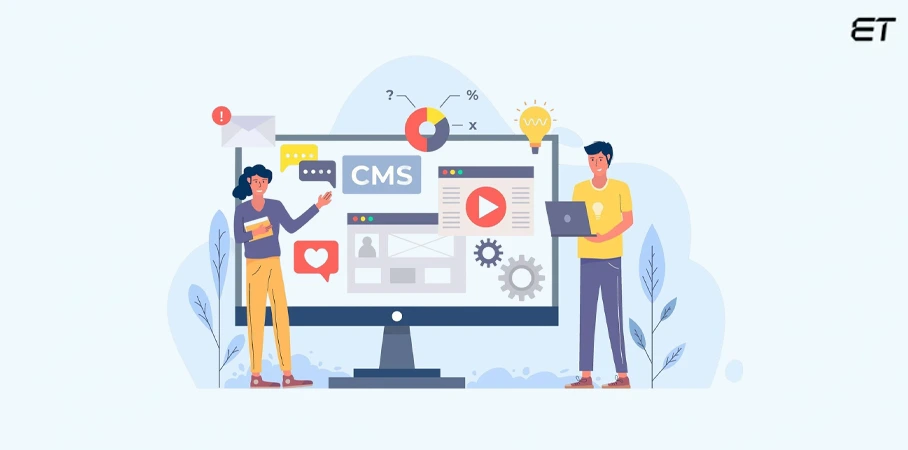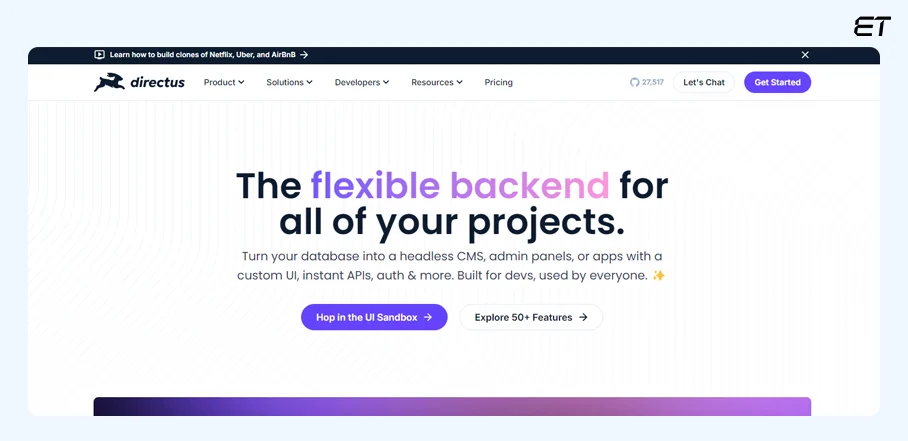
Understand the Concept of Headless CMS
Imagine a CMS that saves content management time and delivers an increment in ROI without much hassle. That’s the impact of headless CMS, and it’s no longer just an imagination.
In fact, the existing decade can belong to this unique type of content management system. How?
Well, experts predict an impressive CAGR of 22.1% (2022 to 2032) in the headless CMS market. This number reflects the improved scalability, security, and performance experienced by companies adopting the headless option over monolithic platforms.
If you aren’t aware of this content management system, read ahead. You will find a simple explanation of this CMS platform and practical reasons to choose/avoid it for your organization.
What is Headless CMS?

Traditionally, content management systems have a tightly coupled architecture. This means the backend has close integration with the front end.
Here, the backend implies content storage, management, and organization.
On the other hand, the front end is the part that facilitates interaction.
In a headless CMS, both sections are separate. This implies the backend content management doesn’t have tight integration with the front-end presentation layer.
Consider the following points:
- Head: Front-end consisting of the UI and content display
- Body: Back-end storing, editing, and sorting the content
So, what is headless CMS?
It is a platform where the head and body are distinct. What does this mean to you?
With this type of platform, you can update the content without affecting the presentation layer (front-end).
| Definition: A headless CMS is a system that segregates the back end, which manages content, from the front end, which presents it. |
Some prominent examples of this type of CMS are Directus, Sanity, ButterCMS, and Strapi.
Need help connecting with certified CMS developers? Contact us and get vetted talent ready to start your project.
How Headless CMS Works?

To understand how headless CMS works, you should first familiarize yourself with the functioning of traditional platforms like WordPress.
Here’s how a traditional or conventional CMS works:
- The system has a tightly coupled architecture that integrates the backend and the frontend
- You create/edit content in an editor (backend)
- The frontend has templates with placeholders that include text, images, links, and other components
- When a user visits your webpage, the system replaces placeholders with your created content
Now, a headless CMS works the following way:
- The decoupled architecture separates the backend from the frontend
- You create/edit content within the backend
- The CMS provides tools for organization, categorization, and content management
- A dedicated application programming interface (API) allows the frontend to access the content
- The frontend requests the API for displaying content to various channels like websites, mobiles, or IoT devices
So, the crux of a headless CMS is simple.
You can create and deliver content to multiple channels without changing the core CMS. Developers can also build the front end using any technology.
Benefits of Using a Headless CMS

The monolithic architecture of a conventional CMS like Drupal or Magento can make it difficult to scale and maintain your content. On the contrary, a headless CMS offers the following key advantages:
- Flexibility
- Scalability
- Improved SEO
- Performance
Let’s break down these positives one by one.
1. Flexibility and Scalability
The headless CMS option allows you to deliver content on any channel, portraying a consistent brand experience across different devices.
Also, developers can leverage the decoupled architecture and customize the presentation to create a unique experience. Regarding scalability, it’s possible to meet the increased traffic by scaling the front end without impacting the back end.
2. Improved SEO
With a headless CMS, you can create and deliver dynamic content at any time. In addition, such a system helps generate SEO-friendly URLs to improve organic ranking. However, you need the assistance of skilled developers for this purpose.
An experienced developer can use responsive design frameworks to ensure your content looks engaging on mobile devices as well. All these factors lead to better SEO performance.
Looking for skilled developers using traditional CMS instead? Hire our WordPress developers who understand the nuances of both content management technologies.
3. Enhanced Performance
Independent scaling and optimized content delivery drastically improve your website’s overall performance. With a headless CMS, you can cache content at the front end. Furthermore, it is possible to integrate such platforms with content delivery networks without hassle.
API optimization is another factor that helps reduce latency and optimize content performance. Together, these factors contribute to superior performance.
4. Cost Effectiveness
The best headless CMS options enable faster development and reusable components. These aspects reduce expenses.
In addition, you don’t need to change your infrastructure to accommodate future growth. As the front and back end are distinct, developers can change one section without impacting the overall system. Also, easier updates lead to heightened cost-effectiveness in the long run.
When to Use a Headless CMS?

Generally, companies use headless CMS to gain more control over content delivery. Still, there are multiple use cases and applications that find the utility of this system useful.
The following table explains some popular conditions for using this content management system.
| Feature | Utility |
| Multi-channel content delivery | Websites, mobile apps, IoT devices, social media |
| Complex content structures | Highly structured content, custom content models |
| Frequent content updates | Rapid changes to content |
| Developer-centric projects | Developers with control over the frontend |
| Large-scale projects | High traffic, complex requirements |
| E-commerce | Product information, content delivery to multiple channels |
| Digital Marketing | Personalized content experiences, targeted content |
When You Should Not Use a Headless CMS?
So far, you are aware of the concept, benefits, and use cases of this type of content management system. However, similar to all technologies, headless CMS has its limitations.
Here are some of the major challenges that you should know before choosing a headless CMS:
- Increased complexity: The decoupled architecture of headless CMS can present additional complexity. This aspect is true for teams with limited experience in frontend development or API integration
- Steeper learning curve: Learning to work with a headless CMS may require a steeper learning curve compared to traditional CMS
- Integration challenges: Integrating a headless CMS with your existing systems or third-party tools can be challenging
- Cost: While headless CMS is cost-effective in the long run, the initial investment may be higher than for its conventional counterpart
- Limited template support: Some headless CMS platforms have limited support for pre-built templates. So, your developers need to create custom templates from scratch
Now, the following table puts forth specific conditions when you should refrain from using a headless content management system:
| Feature | Explanation |
| Simple websites | Basic websites with limited content and features |
| Tightly coupled systems | Projects where the content and presentation are tightly integrated |
| Limited technical resources | Teams with limited experience in frontend development or API integration |
| Legacy systems | Projects that rely heavily on existing legacy systems that may not be compatible with a headless architecture |
| Short-term projects | Projects with a short timeline and limited budget |
| Content-heavy websites | Websites with a large amount of content that may require complex content management tools |
Interested in expanding your knowledge of CMS? We have a comparative blog that differentiates two popular names – Statamic and WordPress.
The Best Headless CMS to Explore
You can find many headless CMS platforms on the market. However, some options stand out for their features, ease of use, and pricing. In this section, you can find some top names with a brief explanation.
Strapi

This open-source content management system puts customization at the forefront. Here are some main points of Strapi to consider:
- It’s an open-source CMS
- The CMS is GDPR compliant
- Strapi has a community of 72K active developers
- It’s useful for building content-driven apps
The self-hosted model offers a free plan with REST and GraphQL API. You can also explore the enterprise model and cloud-based plans as per your requirements.
Contentful

This name is another prominent option that focuses on content modeling and delivery. Contentful has the following main aspects to consider:
- AI-driven intelligent automation
- Visually engaging interface
- Claims to have 100+ apps and integrations
- A composable content platform
Notably, this headless CMS is free to use for individual projects. However, if you want to leverage a multichannel experience, the basic plan of USD 300 per month can prove useful. For more information about its pricing, you can explore the official website.
Directus

If you want a headless CMS built on existing databases, Directus can be a good choice. It has an intuitive admin UI and the following main USPs:
- Robust backend capabilities
- 13K community members
- Policy-based RBAC
- Access to instant APIs
Similar to other content management systems, Directus offers self-hosted and cloud options. Contact them for more details about the pricing.
Headless CMS vs Traditional CMS
The following table summarizes the main differences between the two content management system types.
| Feature | Headless CMS | Traditional CMS |
| Architecture | Decoupled (backend and frontend separated) | Tightly coupled (backend and frontend integrated) |
| Content Delivery | Flexible, can be delivered to multiple channels | Primarily designed for websites |
| Frontend Development | Independent, using various technologies | Limited to CMS templates |
| Scalability | Highly scalable | Can be challenging for high-traffic or multi-channel scenarios |
| Developer Control | More control over frontend | Less control over frontend |
| Content Management | Focus on content creation and management | Handles both content management and presentation |
| SEO | Can be optimized for SEO | SEO can be challenging, especially for complex websites |
| Performance | Generally better performance due to decoupled architecture | Can be slower, especially for complex websites |
| Cost | Can be more cost-effective in the long run | Can be less expensive upfront but may have higher long-term costs |
| Use Cases | Suitable for multi-channel content delivery, complex content structures, frequent updates, developer-centric projects, large-scale projects, e-commerce, and digital marketing | Suitable for simpler websites and projects with limited customization needs |
In a Nutshell
A headless CMS solves many problems you can face with the conventional counterparts. In this content management system, the front end and back end are separate. So, developers can change the content without disturbing the display layer.
Most companies prefer using a headless CMS platform for its scalability, flexibility, and cost-effectiveness. This CMS is also useful if you want to offer your target audience a multichannel experience.
Ensure you hire the best developers to capitalize on this platform’s advantages. Furthermore, vetted programmers can overcome the challenges and ensure the best implementation of the best headless CMS options. You can always contact us for more guidance and get a prompt resolution.
Frequently Asked Questions
1. Is headless CMS just an API?
No. A headless content management system consists of a backend and a front end. The front end connects to the platform’s backend using an API. So, this system is a comprehensive technology comprising the two well-known segments and using API as the bridge.
2. Who uses a headless CMS?
Generally, content creators, developers, marketing teams, and e-commerce businesses use headless CMS. Due to several advantages over the traditional system, many startups and enterprises are investing in such platforms.





